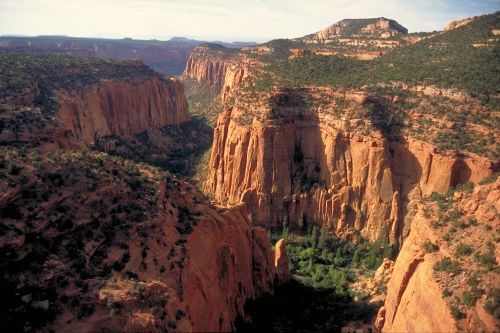To provide observations and information on the emerging fields of landscape scale conservation, heritage preservation, and sustainable community development.
Newsletter
Stay up-to-date with the latest nature, culture and community news.
We won’t spam you or share your information. Newsletters are sent approximately 10 times a year. Unsubscribe at any time.
Observations on the Land and Water Conservation Fund
New Featured Area: Soapstone Prairie Natural Area

Edward Abbey: Seer in the Desert
Re-reading Edward Abbey’s 1968 classic Desert Solitaire, brought some new revelations beyond his lyric descriptions of the desert landscape and sketches of its memorable characters. The book offers some predictions and recommendations for the future of western rivers, National Parks and wilderness. So what were three of his most compelling observations?

The Future of the Bureau of Land Management’s Master Leasing Plans
The Bureau of Land Management (BLM) with 247 million acres of public land in its portfolio and a multiple use mission that includes leasing authority for grazing, mining, oil and gas drilling as well as recreational activities has a challenging job. And nowhere is the work of BLM more difficult than in making leasing decisions adjacent to our National Parks. To help reduce conflicts between BLM practices and the need to protect park resources, the agency had adopted a landscape scale approach to reviewing proposed leasing known as Master Leasing Plans. But today this strategy may be at risk.

Nature and Culture: The Journey Continues
In the conservation world the two faces of nature and culture have become more of a dichotomy than a duality. And yet there is growing recognition that only by taking a more holistic approach can the field address the most urgent issues facing our planet – climate change, urbanization, and the transformations wrought by globalization.Selected reports concerning this nature-culture dialogue are now available in the most recent issue of the George Wright Journal titled “Nature – Culture Journeys: Explorations on Shared Terrain”, the journal shares best practices, insights and examples, as well as personal reflections of the intersections between these two fields.

Culture and Nature: Thoughts on the English Lake District
At every level, conservation practioners labor to understand and balance natural and cultural values at a landscape scale. Globally, this challenge plays out in the push and pull of the World Heritage inscription process. The recent (July 2017) inscription by the World Heritage Committee of the English Lake District highlights some of the challenges and opportunities of attempting to integrate cultural and natural values. There is no question this is a celebrated and iconic landscape, but there have been bumps along the way to gaining World Heritage recognition.

What is in a name? The National Monument Version
National Monuments were once an obscure protected area designation. Today they are the big story in major news outlets. Reporters are struggling with names likes Bears Ears, Grand Staircase – Escalante, and Papahānaumokuākea Marine National Monument. What put these places in the headlines was the new administration’s signature on an Executive Order authorizing a review all National Monuments designated since January 1, 1996 and specifically those over 100,000 acres. The rush is on to learn more about national monuments.

Edward Abbey: Seer in the Desert
Re-reading Edward Abbey’s 1968 classic Desert Solitaire, brought some new revelations beyond his lyric descriptions of the desert landscape and sketches of its memorable characters. The book offers some predictions and recommendations for the future of western rivers, National Parks and wilderness. So what were three of his most compelling observations?

The Future of the Bureau of Land Management’s Master Leasing Plans
The Bureau of Land Management (BLM) with 247 million acres of public land in its portfolio and a multiple use mission that includes leasing authority for grazing, mining, oil and gas drilling as well as recreational activities has a challenging job. And nowhere is the work of BLM more difficult than in making leasing decisions adjacent to our National Parks. To help reduce conflicts between BLM practices and the need to protect park resources, the agency had adopted a landscape scale approach to reviewing proposed leasing known as Master Leasing Plans. But today this strategy may be at risk.

Nature and Culture: The Journey Continues
In the conservation world the two faces of nature and culture have become more of a dichotomy than a duality. And yet there is growing recognition that only by taking a more holistic approach can the field address the most urgent issues facing our planet – climate change, urbanization, and the transformations wrought by globalization.Selected reports concerning this nature-culture dialogue are now available in the most recent issue of the George Wright Journal titled “Nature – Culture Journeys: Explorations on Shared Terrain”, the journal shares best practices, insights and examples, as well as personal reflections of the intersections between these two fields.

Culture and Nature: Thoughts on the English Lake District
At every level, conservation practioners labor to understand and balance natural and cultural values at a landscape scale. Globally, this challenge plays out in the push and pull of the World Heritage inscription process. The recent (July 2017) inscription by the World Heritage Committee of the English Lake District highlights some of the challenges and opportunities of attempting to integrate cultural and natural values. There is no question this is a celebrated and iconic landscape, but there have been bumps along the way to gaining World Heritage recognition.

What is in a name? The National Monument Version
National Monuments were once an obscure protected area designation. Today they are the big story in major news outlets. Reporters are struggling with names likes Bears Ears, Grand Staircase – Escalante, and Papahānaumokuākea Marine National Monument. What put these places in the headlines was the new administration’s signature on an Executive Order authorizing a review all National Monuments designated since January 1, 1996 and specifically those over 100,000 acres. The rush is on to learn more about national monuments.


